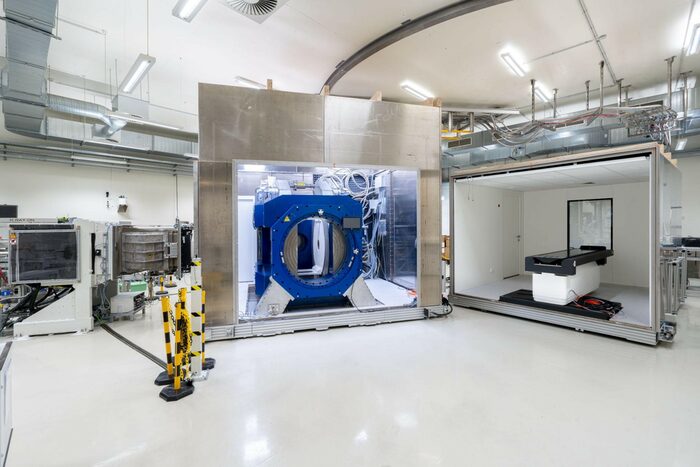|
Landeshauptstadt Dresden - www.dresden.de https://www.dresden.de/en/business/tomorrow-s-home/news/2024/002-onco-ray-mrt.php 24.06.2024 16:21:11 Uhr 22.04.2025 04:22:33 Uhr |
|
New research device in Dresden enables unprecedented precision in cancer therapy

Dresden has recently acquired a large-scale medical device that combines a proton system with a whole-body MRI scanner. This makes it unique in the world - and catapults Dresden to the forefront of cancer therapy research! The real-time MRI images and data enable unprecedentedly precise proton irradiation.
The use of protons is currently one of the most promising therapies in the fight against cancer. Positively charged particles (protons) are generated and fired at the target tissue at 180,000 kilometers per second. Not only can the direction of the proton beam be determined, but also how far it should penetrate the body. When it reaches its target, an explosive discharge occurs - the tumor is destroyed and only minor damage is caused to adjacent tissue.
A large-scale medical device has now been put into scientific operation in Dresden, which should provide new impetus. It enables even more precise irradiation, increasing the chances of successful treatment on the one hand and protecting the health of patients on the other. This is a globally unique combination of MRI device and proton therapy system.
The novelty: the tumor can be tracked in real time during proton irradiation. Unlike conventional imaging methods such as X-rays, MRI real-time images show the soft tissue in detail and with millimeter precision. This allows the proton beam to be positioned and the tumor to be targeted precisely. The researchers' aim is to use the prototype to develop a new form of cancer treatment: The proton beam should only be active when the tumor is exactly in its focus. If it moves millimeters away, the radiation stops.
The research device is set up in the experimental room of the proton therapy facility of the "OncoRay - National Center for Radiation Research in Oncology" research network on the premises of Dresden University Hospital. The facilities there offer excellent conditions for advancing the unique research work in an interdisciplinary team.
"OncoRay sees itself as a cross-institutional research platform for medical radiation research in Dresden with a particular focus on translational research," explains Prof. Esther Trost, Dean of the Faculty of Medicine and Director of the Clinic and Polyclinic for Radiotherapy and Radiation Oncology. "The prototype that has now been inaugurated fits perfectly into this special research environment."
At the inauguration of the facility, Saxony's Minister President Michael Kretschmer spoke of a "milestone for Saxony as a science location": "It is an example of the potential and knowledge that is available here." Prof. Michael Albrecht, Medical Director of the University Hospital Dresden, spoke of an "innovative leap" made possible by the large-scale facility and emphasized Dresden's pioneering role in oncology.
However, it will be some time before the new form of therapy can be used in practice: The first patients could be treated with it in five to six years.






